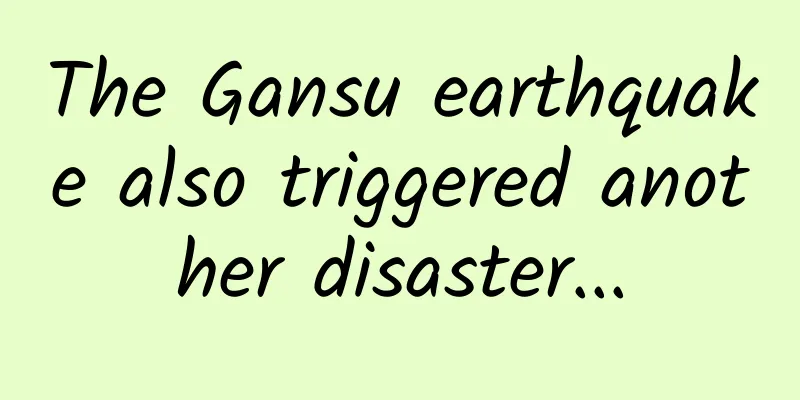The Gansu earthquake also triggered another disaster...

|
At 23:59 on December 18, a 6.2-magnitude earthquake struck Jishishan County, Linxia Prefecture, Gansu Province. It was midnight in the dead of winter, the worst time. Within a few minutes, the tremors spread to Xi'an, Xining, Lanzhou and other places. As of now, at least 113 people have been killed. Behind the bloody numbers are the disappearance of lives. Source | Weibo screenshot Even people who have not personally experienced an earthquake can imagine the scene when an earthquake strikes, with the earth rumbling and everything collapsing, by watching on-site surveillance videos and post-disaster news reports. The moment of the earthquake captured by camera Source: Toutiao In addition, the earthquake also triggered another disaster - sand surge. It is hard to imagine that in the middle of winter, when the ground was already frozen hard by the cold wind, a sudden landslide and a flood of mud surged out, with the wave reaching 3 meters high, covering the sky and the earth, as if it was endless. Two villages in Minhe County, Haidong City, Qinghai Province, bordering Jishishan County, Jintian Village and Caotan Village, were surrounded, covered and washed away by the sand, causing 20 people to lose contact. After the incident, the Qinghai Provincial Fire Rescue Corps organized a rescue operation overnight. Source | Xinhua News Agency "Unexpectedly, the sound was very loud" Source: CCTV News Screenshot So, what is sand surge? 1 Where does the sand come from? After many major earthquakes, the so-called "sand surge phenomenon" occurs. After a strong earthquake, due to the vibration of the earth's crust, the water-containing sand deep underground will experience a strong liquefaction phenomenon. The liquefied sand layer is squeezed and deformed along a certain channel and reaches the surface directly, forming a "sand surge". Simply put, when you go to the beach or river, you may find that the ground near the water source will ooze out water when you step on it, and it will become softer and softer, and even become like mortar or mud. This is soil liquefaction . When this liquefaction occurs deep in the earth, the soil will gush out from the cracks like "squeezing butter". Source | See watermark This phenomenon was first proposed in 1953. It was not until 1964 when two major earthquakes occurred in Alaska, USA and Niigata, Japan, triggering significant liquefaction phenomena and disasters that earthquake liquefaction research began to be taken seriously by the scientific research and engineering communities. According to research, not all soils will liquefy when encountering an earthquake. For example, no cases have been found where an earthquake below magnitude 5.0 has triggered soil liquefaction. Source: Sichuan Earthquake Administration Generally speaking, soil liquefaction requires four conditions : first, the soil (non-viscous) is in a relatively loose state, and dense or viscous soil will not liquefy; second, the soil is below the groundwater level, and the pores in the soil are filled with water (that is, "soaked" by water), that is, the soil is in a saturated state; third, the round-trip dynamic load of the earthquake must be strong enough (that is, the magnitude of the earthquake must reach a moderate or strong earthquake), and too small an intensity is difficult to trigger liquefaction; fourth, the soil is in a closed state to ensure that water during the earthquake period cannot quickly penetrate into the surrounding area. Therefore, soil liquefaction is not a special geological phenomenon, but it does not occur in just any place. This time, the sand surge appeared in Jintian Village, which is closely related to a nearby river. Source: CCTV News According to Qi Fenyong, a village official in Zhongchuan Township, Minhe County, Qinghai Province, "There used to be a dry ditch next to this place, which had a little water during the summer rainy season, but usually had no water in the ditch. After the earthquake, the groundwater level was relatively high, and all the mud underneath was turned up. There was a second-level step on the north side, and the soil was relatively loose, so it was washed down." 2 Is it only sandy soil that will liquefy? When talking about earthquake soil liquefaction, it is generally called "sand liquefaction". In fact, this name is narrow or inaccurate. Most of the liquefied soils found in early earthquake damage surveys were sandy soils, so "sand liquefaction" gradually became a common name and took root in public perception. However, with the continuous accumulation of post-earthquake survey data, the actual liquefied soil types are also expanding . For example, after the Tangshan earthquake in 1976, a large amount of silt (particle diameter is smaller than sandy soil) liquefaction was found. The 2008 Wenchuan earthquake confirmed the world's largest-scale liquefaction of natural sedimentary gravel soil (particle diameter is larger than sandy soil). The 1993 Guam earthquake in the United States and the 2010 Haiti earthquake saw coral soil liquefaction . There are also studies showing that loess can also liquefy , etc. These earthquake damage phenomena have greatly expanded the scope of liquefiable soils, and sandy soil liquefaction is just one of them . 3 Sand surge has no direct relationship with aftershocks Since the beginning of this century, in several major earthquakes at home and abroad, the proportion of engineering damage and social disasters caused by soil liquefaction has become increasingly larger, so soil liquefaction has been called a "cancer" in earthquake prevention and disaster reduction by scholars, becoming an increasingly fierce invisible killer. From a macroscopic perspective, soil liquefaction can cause corresponding forms of earthquake damage, such as water and sand spraying (Figure 2a), lateral displacement and expansion (Figure 2b), flow damage (Figure 2c), reciprocating surface oscillation (Figure 2d), ground subsidence (Figure 2e), and loss of bearing capacity of the foundation (Figure 2f). Image source: Ministry of Emergency Management But in this earthquake, sand surges are related to the water content of the underground aquifer and the degree of compression and deformation . More sand surges do not necessarily mean that there may be a major earthquake in the future; the absence of sand surges does not mean that it will be safe in the future; there is no direct relationship between the two, it is just a normal phenomenon. 4 How to prevent and control soil liquefaction during earthquakes? At present, the main means of preventing soil liquefaction during earthquakes is to predict the possibility of liquefaction at the engineering site before the earthquake, and then adopt appropriate foundation reinforcement methods based on the prediction results and the importance of the building . This method has been written into the seismic design specifications of various countries. Among them, the liquefaction identification method in the "Code for Seismic Design of Buildings GB 50011-2010" is proposed by Chinese scientists. It is suitable for China's national conditions, has Chinese characteristics, and is the most widely used and authoritative liquefaction identification method in engineering. It is called the "Chinese method" by international scholars. The following defense measures are usually adopted for sites where liquefaction is possible: replacing liquefiable soil with non-liquefiable soil, lowering the groundwater level or reducing the saturation level of liquefiable soil, increasing the density of liquefiable soil, enhancing drainage so that pore pressure can dissipate quickly during an earthquake, and using composite foundations to increase the strength of liquefiable soil. However, compared with the seismic reinforcement measures for buildings, the current treatment of liquefiable foundations still has problems such as complex technology and high cost, which is one of the important reasons why large-scale and serious liquefaction disasters still occurred in recent major earthquakes, including in many developed countries. In this project, we are not facing products that we have independently selected, researched, analyzed and designed, but natural rock and soil with complex properties, which makes the problem more complicated and the research more difficult. Up to now, due to the cold weather, the sand stream in Jintian Village is still in a semi-frozen state. Rescuers are using stones, firewood, etc. to pave a life-saving passage in the sand stream for rescue operations, while using excavators to clear the silt. Image source: Beijing Daily Let us pray for the affected villages in Qinghai, hoping that they can resume normal life and work as soon as possible. At the same time, we also hope that everyone can pay attention to the prevention and response of natural disasters and jointly protect our homeland. Contents are compiled from: CCTV.com, Beijing Daily, Beijing Evening News, Qinghai Daily, Xin Kuai Bao, China Life, Beijing News Radio, Hualong.com, The Paper, CCTV News, Sichuan Provincial Seismological Bureau |
<<: Will you grow nodules if you are often angry? The truth is...
>>: Mobile phones are also afraid of the cold in winter. How to keep them warm?
Recommend
Take stock of the brand marketing strategies spawned by anxiety!
• Introduction• The tiny cracks in human nature a...
China Automobile Dealers Association: Tracking of some data on China's automobile exports overseas from January to June 2023
Since 2021, with the outbreak of the global COVID...
What kind of smartphone do we need in 2015?
January 29 (Reporter Zhang Zhichang) At the fourt...
How much does it cost to produce Zhangye Printing Mini Program? Zhangye printing and printing applet production price inquiry
In order to better penetrate into various industr...
What is it like to go from 386th in the overall ranking to 1st?
In the past half month, the rankings of many APP ...
Mooncake trivia | Can you believe it? Fruit mooncakes are actually made of winter melon!
According to GB/T19855-2023 "General Rules f...
Essential: 126 tools and 15 promotion channels for a complete event planning
"What tools are needed for a complete event?...
Beware! The “strongest invasive pest on earth” is entering its active period
As the weather warms up, red fire ants enter thei...
Why is there always a queue in the women's restroom? What do girls do in there?
Follow "Body Code Decoding Bureau" (pub...
Still the familiar Xiaomi, Xiaomi 8 detailed review
Xiaomi officially released its 8th anniversary pr...
It’s heartbreaking that a woman fell from a building after being cyberbullied. How should we build a “psychological firewall” in the face of verbal abuse?
It’s heartbreaking that a woman fell from a build...
What are the operating routines of B-side products?
It is widely circulated both among the public and...
Where is the traffic pool for educational institutions in 2021?
In 2020, affected by the COVID-19 pandemic, the o...
The underlying logic of short video operations!
The power of short videos is 9 times that of long...
Will eating these things often really make you ugly? Beware of these 8 types of food
Someone once complained online: "Why do I fi...









